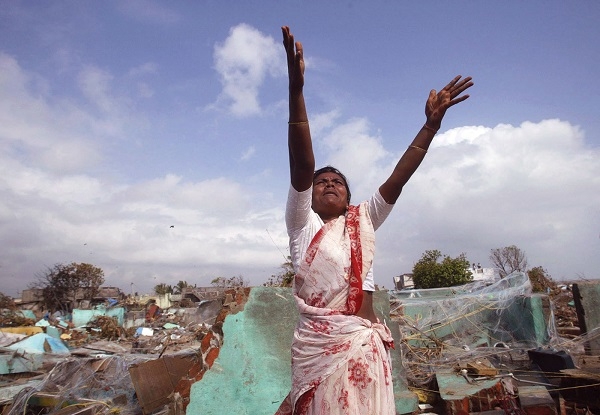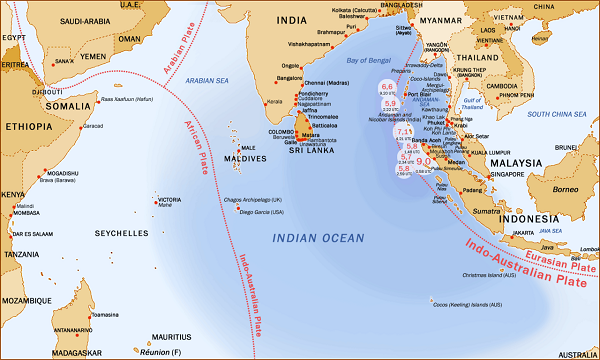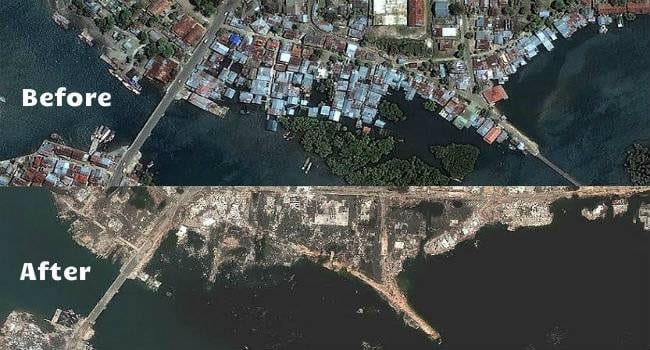2004 Indian Ocean Tsunami - The reason behind 'World Tsunami Awareness Day'
Total Views | 286
In December 2015, the United National General Assembly designated 5 November as World Tsunami Awareness Day, calling on countries, international bodies, and civil society to raise tsunami awareness and share innovative approaches to risk reduction. It also encourages the development of national and community-level, local disaster risk reduction strategies to save more lives against disasters.

The term ‘Tsunami’ is a Japanese term which means “harbour wave”. A tsunami is a series of giant waves caused by earthquakes or undersea volcanic eruptions and underwater landslides. These waves can travel at the speed of 800 km/hour and its height can be 20 feet to 300 feet. The speed of tsunami waves depends on depth of the ocean. The speed of tsunami is fast in deep water while slow down when reaching shallow waters. It is worth to be noted that around 80% of tsunamis occur in the Pacific Ocean.
Tsunamis are rare but extremely deadly waves. In the past 100 years, 58 tsunami incidents have claimed more than 2.6 lac lives, or an average of 4,600 per disaster. These death tolls have made a tsunami as the most dangerous natural disaster. The deadliest Tsunami ever was recorded in the Indian Ocean in December 2004. It caused an estimated 2.27 lac deaths in 14 countries including India, Sri Lanka, Thailand, and Indonesia.
Following the 2004 deadliest Tsunami, the UNGA decided to observe 5 November as World Tsunami Awareness Day with an aim to increase awareness about the Tsunami among over 700 million people live in low-lying coastal areas and Small Islands.
Japan was the brainchild behind this day being designated as World Tsunami Awareness Day due to its repeated and bitter experience, the country had felt over the years. It has built up major expertise in areas such as tsunami early warning, public action and building back better after a disaster to reduce future impacts.
The reason why the day - November 5 - is observed as World Awareness Day are many but out of those many reasons, the main was the tragic and deadly 2004 Indian Ocean Tsunami occurred.
2004 Indian Ocean Tsunami
On 26 December 2004, a major undersea earthquake that took place on the coast of Sumatra island, Indonesia was set off the 2004 Indian Ocean tsunami, also known as the Christmas or Boxing Day tsunami on Sunday morning. The earthquake caused the ocean floor to suddenly rise by as much as 40 meters, triggering a massive tsunami.

Within few minutes, the first of several 100-foot waves hit the shoreline of Banda Aceh, killing more than 100,000 people and pounding the city into rubble. Then, in succession, tsunami waves rolled over coastlines in Thailand, India, and Sri Lanka, killing tens of thousands more.
In India, the tsunami arrived in the states of Andhra Pradesh, Tamil Nadu, and Kerala. Tamil Nadu, the union territory of Pondicherry and Kerala were extensively damaged, while Andhra Pradesh sustained moderate damage. The tsunami also arrived in the Andaman and Nicobar Islands minutes after the earthquake causing extensive devastation to the islands' environment. Specifically, the Andaman Islands were moderately affected while the island of Little Andaman and the Nicobar Islands were severely affected by the tsunami.
According to official estimates in India, 10,749 people were killed, 5,640 people were missing and thousands of people became homeless when a tsunami triggered by the 2004 Indian Ocean earthquake. The worst affected island in the Andaman & Nicobar chain is Katchall Island, with 303 people confirmed dead and 4,354 missing out of a total population of 5,312.

Eight hours later and 5,000 miles from its Asian epicenter, the tsunami claimed its final casualties on the coast of South Africa. In all, nearly 230,000 people were killed, making it one of the deadliest disasters in modern history.
Since the 2004 tsunami, governments and aid groups have prioritized disaster risk reduction and preparedness. Only three weeks after the tsunami, representatives of 168 nations agreed to the Hyogo Framework for Action, which paved the way for global cooperation for disaster risk reduction. Since then, ocean floor earthquake sensors have been installed to trigger early warnings, and many local communities have been trained in evacuation and disaster response.
This had brought many things to consider in order to develop risk assessment systems to alert people in the event of potential tsunamis. The scale of devastation across the eastern coast exposed the country’s lack of preparation and scientific knowledge that could have mitigated the impact of the disaster.
However, along with Australia and Indonesia, India is one of three regional tsunami service providers that send warnings and seismic updates to countries in the Indian Ocean region. The Indian Tsunami Early Warning Centre, launched by the government under the Indian National Centre for Ocean Information Services in 2007, collects and analyses seismic data through a network of sensors across the Indian Ocean.
In August, the center launched a real-time modeling system that uses mapping data to simulate within minutes the exact time and scale of impact of a tsunami across the Indian coast. Around 26% of the country’s population lives within 100 km of the coast. The early warning center was one of several measures the government took to address natural disasters after the 2004 tsunami, including setting up a National Disaster Management Authority, which was notified in the Disaster Management Act of 2005.
Currently, there are many technologies and disaster managements that can detect tsunamis and take are of the aftermath of the tsunamis. Having said that, it also important to create more such tech and manage such deadly disasters or else being AWARE of the tsunami!
Bharati Web






